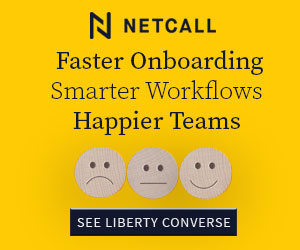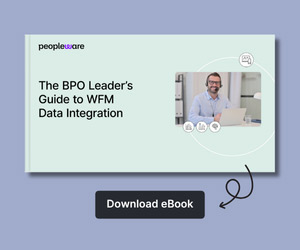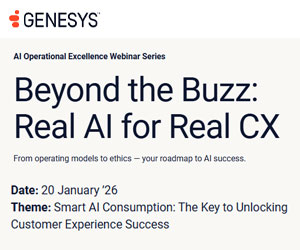As artificial intelligence (AI) continues to reshape how businesses operate, one area that is currently undergoing a profound transformation is quality assurance (QA). Traditionally seen as a back-office function, QA is now emerging as a powerful driver of customer insight.
To understand what’s changing and just how organizations can get QA right, we sat down with Jaime Scott, CEO of evaluagent, to cast a spotlight on what their customers are doing right.
Rethinking QA – From Spreadsheets to Strategy
The truth is, QA can often go underappreciated. In many organizations, it’s buried under spreadsheets and manual tracking systems, disconnected from broader business objectives. But AI is changing the equation.
A lot of new AI-driven QA platforms promise full automation, analysing every customer conversation across every channel, scoring interactions, and surfacing insights at scale.
Yet for many leaders, that leap from manual sampling to a black box of automation feels too big, too soon. “The fear isn’t about missing out on technology,” Jaime told us, “It’s about messing it up.”
Rather than pushing for total automation overnight, businesses should work closely with clients and internal teams to blend AI into existing workflows that are already familiar. Change can be difficult, so the key is to make the technology feel like a natural extension of what teams already do, not a foreign replacement for it.
By creating this blend, a strong baseline of trust can be established. QA teams, supervisors and agents must see how AI supports their work, not undermines it. It’s about collaboration, not just trying to sell AI as the ultimate solution to all QA problems.
Immediately jumping to 100% of your QA tasks being done through AI is not the aim. Instead, the goal should be to incorporate a step-by-step process that positions automation as a tool that enhances QA, all while freeing up agents to focus on high-value activities like developing their own skill set, coaching others and improving problem solving.
Change takes time, especially when it’s not only operational but also cultural. Scaling with AI can’t happen all at once – it needs to take people on a journey.
Otherwise, you run the risk of clashing with the same old problems we’ve always faced with AI, namely not feeling as though you can trust the results that come from it.
Ultimately, successful QA transformation starts with a simple principle: don’t just automate a tick-box exercise that no one believes in. Use AI to elevate the purpose of QA, to genuinely improve quality, empower your agents and deliver better outcomes for customers.
Watch the video below where Xander Freeman discuses how to get QA done right with evaluagent CEO Jaime Scott:
How Do We Automate QA in the Right Way?
Scaling QA is an appealing proposition. If a business was given the choice of analysing 3% of their data vs. 99% of their data, who wouldn’t go for the 99%?
But quantity isn’t the same as quality. The real question is whether that 99% is being done right.
Automation has immense power, but it also introduces risk if not implemented carefully. AI models can process vast amounts of data quickly, but they still require human oversight to ensure accuracy and fairness.
The ideal set-up is a co-pilot model, where AI handles repetitive, objective tasks and humans provide insight on the most complex, highly emotive queries.
So, how do we achieve this? The key part of the whole process is developing agents who are more motivated and more capable than ever, backed up by reliable automation.
Using actionable, trustworthy data from the right kind of AI implementation can build the foundation for coaching your agents, freeing up time to improve their performance, and focus on enhancing customer experience.
However, automation done right doesn’t happen with the flick of a switch. AI systems must be trained, optimized and continuously refined to achieve accuracy and consistency.
We must keep up with knowledge management and be aware of what’s in our dataset to get the results we’re after – as the old saying goes, “rubbish in, rubbish out”.
When implemented thoughtfully, AI-driven QA delivers quality at scale. It reduces bias, increases coverage and creates a consistent standard for measuring performance across teams and regions. But most importantly, it turns QA into a living system of continuous improvement rather than a static process.
Turning QA Data Into Business Intelligence
Traditional QA reports often stay within the contact centre, serving as internal data points. But in reality, QA data holds far greater value – it’s a goldmine of business intelligence.
Every customer interaction contains rich insight about what’s working (and what’s not) across marketing, products, operations and more.
Customers don’t compartmentalize their feedback – they voice their frustrations and praise freely when contacting a company, revealing the full story of a company.
By utilizing AI-driven QA and evolving it into what Jaime dubs ‘Quality Intelligence’ (QI), we can connect the dots between customer conversations and business outcomes, transforming QA from merely a monitoring function into a strategic asset.
As Jaime says, the ability to score QA while collecting and analysing this business-wide insight can lead to a treasure trove of actionable information.
For example, a large portion of evaluagent’s client base contains organizations in regulated industries, such as online gambling and gaming clients increasingly looking to evaluagent’s services to uncover the root cause of customer dissatisfaction.
In one such case, when using QI, Jaime and his team were able to find that three-quarters of repeat contact demand stemmed from just four recurring issues.
Fixing one back-office process that was driving those repeat contacts managed to reduce inbound demand by almost a third – saving hundreds of thousands of dollars and dramatically improving customer satisfaction.
“All of a sudden, you’ve got this powerhouse of data inside your contact centre.”
QA insights can uncover broken processes, identify training needs, inform product design and even shape marketing campaigns. Plus, they can spotlight positive behaviours, showcasing examples of excellence that inspire teams and strengthen culture.
As QA insights become more visible to leadership, the QA team itself evolves. It becomes a centre of influence and drives phenomenal change. Board members start asking for QA-driven insight to guide strategic decisions, and analysts and auditors turn to QA teams for evidence of customer insights.
For QA professionals, this creates new and exciting career opportunities, and the people who may have once worked solely on isolated spreadsheets are now helping steer the wider business.
QA as a Competitive Advantage for Mid-Size Contact Centres
For mid-size contact centres, finding the balance between resources and expectations can be challenging. They aren’t permitted the benefit of a smaller team with access to more intimate, one-to-one coaching, nor the funding of an enterprise level contact centre.
This is where AI-powered QA can level the playing field and help to turn customer conversation into a competitive advantage.
Automation enables mid-size centres to scale QA coverage from a manual sample of 5% to an automated sample of 80–100% of interactions without scaling costs.
This broader visibility isn’t just about catching compliance risks, it’s about proactively improving performance, guiding agents in real time and identifying opportunities for growth.
Imagine an AI system that can flag when an agent might be missing an empathy cue, struggling with complex conversations, or encountering a vulnerable customer. Supervisors can then step in, coach effectively, and even provide support mid-interaction. That kind of agility transforms both customer experience and agent morale.
Automated QA can help to mitigate compliance risks by detecting issues in the moment, reducing both business and customer risk, all while ensuring that every client and every advisor is treated fairly.
The benefits all compound quickly, seeing reduced complaints and rework through early issue detection, improved agent motivation via real-time coaching and feedback, enhanced customer trust through consistent and empathetic interactions, operational efficiency as call summaries and wrap-ups become automated, and more!
All this breathes life into a culture of continuous development, for both the individual agent and the company as a whole.
A dedicated empowered QA team grants return on investment and becomes a board-level lever, demonstrating clear return on investment through better performance, driving growth, improving efficiency and granting a competitive advantage.
What’s Next for QA?
As AI continues to evolve, the possibilities for QA will expand even further. Machine learning models will become more capable of understanding emotion, context and intent, and agentic workflows will autonomously handle repetitive tasks while highlighting insights for human review.
But no matter how advanced technology becomes, the essence of quality assurance will remain the same: to ensure every customer interaction meets (or exceeds) expectations.
The future of QA is not 100% automation. It’s human-centred automation, where technology scales and supports, and people interpret, guide and improve.
The best implementations blend technology with culture. They use AI to make feedback faster and fairer, but they keep people at the heart of the process. They empower agents to learn from data rather than mistrust it, and they involve them in the journey of continuous improvement.
The shift from reactive to proactive QA is especially important. Reactive QA looks backward, reviewing a sample of calls to identify what went wrong. Proactive QA looks forward and predicts issues before they happen, guiding agents in the moment and using data to prevent problems altogether.
Clients and organizations that embrace customer experience as a true competitive advantage are the ones that get this right, and QA gives them an opportunity to make everything that they do bigger and better.
When you blend automation with empathy, intelligence and intent, QA doesn’t just measure quality – it creates it.
Author: Xander Freeman
Reviewed by: Robyn Coppell
Published On: 3rd Nov 2025 - Last modified: 5th Nov 2025
Read more about - Expert Insights, Artificial Intelligence (AI), Automation, Customer Experience (CX), Employee Engagement, EvaluAgent, Jaime Scott, Quality





































